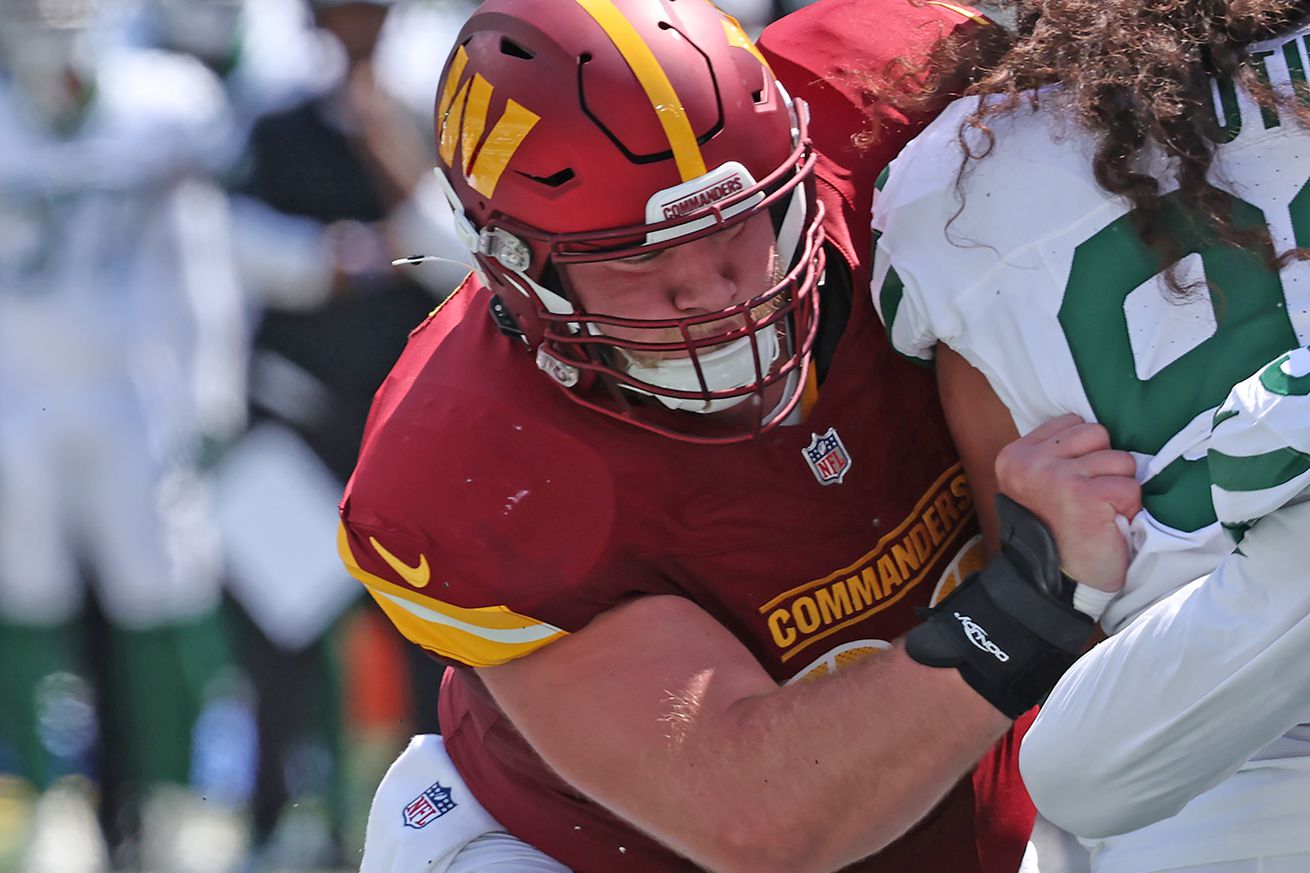
Bolstering the weakest link in Jayden Daniels’ blocking unit
The offensive line has been one of the major topics for Commanders’ fans throughout the first five months of Adam Peters’ top to bottom roster “recalibration”. A disproportionate amount of attention has been focused on the situation at offensive tackle.
Earlier this offseason, I did a deep dive into the Commanders’ issues in pass protection in 2023. The analysis showed that left guard was actually the weakest position on the Commanders’ offensive line last season, allowing 64 pressures compared to 62 credited to the right tackles. That is remarkable, because guards usually allow lower Pressure Rates in pass protection than offensive tackles. While starting right tackle Andrew Wylie ranked 20th among starting right tackles, left guard Saahdiq Charles ranked dead last among starting guards. Chris Paul, was even worse when he took over from Charles for seven games.
The reason that the left guard situation hasn’t generated as much angst as OT seems to be a perception that more was done to shore up the position this offseason. But was it really? The Commanders drafted OT Brandon Coleman in the third round. Coleman exceeded expectations in training camp and, despite battling with injury, has already displaced Cornelius as the starting LT on the first unofficial depth chart.
By comparison, the only offseason additions on the interior offensive line, aside from new starting center Tyler Biadasz, were former Chiefs’ backup LG Nick Allegretti and two backup centers. Michael Deiter has bounced between starting and backup roles at center in five seasons with Miami and Houston. J.C. Hassenauer was a backup center for the Steelers through his first three NFL seasons, and spent 2023 on the Giants’ injured reserve list. Both Deiter and Hassenauer have got some playing time at LG in their careers. However, neither they, nor presumptive starter Nick Allegretti have earned and held onto a primary starting role with their previous teams.
The new additions have each got playing time at LG in the preseason, where they are competing for roster spots with returning players Chris Paul, Ricky Stromberg and late 2023 addition Julian Good-Jones.
Is the starting situation and depth at LG really in a better place than either OT position? Or will the weakest link on last season’s offensive line continue to be the biggest problem in 2024? To get a better handle on the prospects of seeing an improvement at LG in 2024, I had a looking at the blocking stats for all of the players competing for the starting LG position and backup iOL positions this preseason.
Blocking Metrics
Readers who are not particularly interested in the technical details of blocking stats might consider skipping past this section
From a statistical standpoint, evaluating blocking performance poses much greater challenges than offensive skill positions and defensive positions which produce large volumes of objectively measurable production statistics. No matter how it is done, measuring blocking performance involves some level of subjective judgement, which is bound to lead to controversy sooner or later. That is likely to remain the case until AI takes over.
Blocking performance has two phases, which pose different challenges. In pass protection, the blocker is acting in a defensive capacity. If he holds his block to keep the defender out of range of the QB, he has nearly always done his job. In the running game, blockers go on the attack. Simply holding a block can result in clogging a running lane. Successful run blocking often requires moving a defender out of the way to create running lanes. In my opinion, available metrics do a better job of quantifying performance in pass protection than run blocking.
Pass Blocking
This offseason I have settled on Pressure Rate as my preferred metric for pass blocking performance. Pressure Rate is the percentage of pass blocking snaps on which a blocker allows a pressure (QB hurry, sack or QB hit). Raw pressure counts and blocking snap data are sourced from Pro Football Focus (PFF) Premium Stats, which break down every player’s activity on every snap using defined criteria. PFF Premium Stats should not be confused with PFF Player Grades, which assign subjective grades to each player’s contribution to the outcome of each play, even though they might be marked by the same analysts.
Pressure Rate is a direct measure of productivity in pass blocking, based on clearly defined criteria. As such, it is an improvement over more subjectively based Blocking Grades and indirect measures like Blocking Win Rates.
In commentary on my last article, Mark Tyler raised a concern about PFF’s grading of pressures, based on a controversial play by Chris Paul in a preseason game. Mark suggested that Sports Info Solutions might be a better source of blocking data. Mark raises a great point. It is good practice to cross-validate your data sources whenever possible.
To check whether PFF and another reputable stats service might be grading blocking differently, I compared Pressure Rate data derived from PFF pressure counts to SIS Blown Block Rates for the same players in pass protection. To make this comparison, I used the dataset I have previously compiled on Pressure Rates for every starting OT in 2023.
In making this comparison, it is important to note Pressures allowed and Blown Blocks measure different, but closely related aspects of blocking performance. A Blown Block is counted when the defender gets past his blocker. It doesn’t become a Pressure, unless the defender gets close enough to the QB to influence the play. Consequently, we wouldn’t expect perfect agreement between the two metrics, even if they were being graded by the same analysts. With that qualification in mind, let’s see how the two pass blocking metrics compared.
The following graph plots Pressure Rate vs Blown Block Rate for 62 starting OTs in 2023. SIS data was not available for Geron Christian (CLE) or Braden Smith (IND).
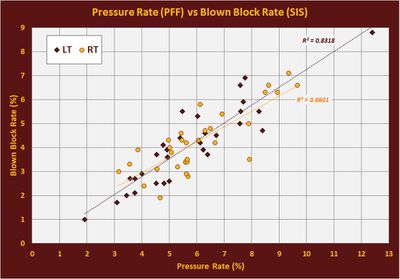
There was very strong agreement between the two metrics, despite the fact that they measure somewhat different things. The correlation between Pressure Rate and Blown Block Rate was particularly strong among LTs, with a Pearson’s correlation coefficient of 0.91 (83% of variance explained). There was a more discrepancy between the two measures among RTs. Nevertheless, the correlation was still compelling, with a correlation coefficient of 0.81 (66% of variance explained). The high degree of agreement between two data sets produced by different stat services, measuring pass blocking in different ways, indicates that they are both seeing essentially the same things.
As for Washington’s 2023 starters, RT Andrew Wylie ranked 20th among starting RTs by Pressure Rate and was in a three way tie for 18th place by Blown Block Rate. Since the three tied players effectively block out 18th through 20th places, that means the two metrics ranked his performance the same. LT Charles Leno ranked 16th in the league by Pressure Rate and 19th by Blown Block Rate. His ranking differs three places out of 32 (9.4%) when using the different metrics.
Based on these results, I am comfortable that the two metrics grade pass blocking performance similarly. In this article I will use both, to enable cross checking. SIS preseason data is behind a paywall, so I will continue using PFF data for the next two games, with even greater confidence than before.
Run Blocking
I am not yet sold on any available run blocking stats. SIS Blown Block Rates might be an improvement over PFF’s more subjective Run Blocking Grades, so I have used them in this article.
However, I have a feeling that the Blown Block criterion misses half of the range in grading run blocking. Simply holding a block on a defender might be a success on some running plays. But it might result in clogging a running lane on others. The Blown Block criterion does not seem to differentiate between the two. It is useful for identifying blocking failure, which is probably enough to differentiate good pass blocking from bad pass blocking. However, it does not appear to be able to differentiate just adequate run blocking from good run blocking.
What is needed is a run blocking metric that gives extra points for moving a defender out of the way. Despite their greater subjectivity, PFF Run Blocking Grades could possibly have an advantage in this respect. But that is a subject for another day and a different writer.
The Contestants
All signals from the coaching staff seem to indicate that Nick Allegretti has locked up the starting LG job to start the season. I have some doubts about whether he will keep it, based on his past performance, which we will get into in a minute.
Behind Nick on the iOL depth chart are five players competing for backup roles, who might have a shot to push for playing time as the season unfolds. The following roundup includes all the interior offensive linemen on the Commanders’ current roster who have experience at left guard, or have been tried at left guard in the first two preseason games. I have grouped them into players with significant NFL playing experience and those with negligible experience. Let’s see how they stack up based on available blocking data at the NFL level.
Experienced Veterans
Players with substantial NFL experience were graded based on their blocking stats in any season when they had more than 100 snaps in pass protection or run blocking. The stats used were Pressure Rate (Percentage of pass block snaps allowing pressure), derived from PFF pressure counts, and Blown Block Rates for pass and run blocking, sourced from SIS (regular season only).
Letter Grades – to make the blocking stats more user friendly, I converted them to letter grades by grading on a bell curve, just like in school if you are really old. The letter grades show how a player rates against the starters at their position in 2023. To generate the letter grades, I calculated z-scores. These show how far above or below the average (mean) a player’s blocking stat is, in units of standard deviation. For example, a z-score of 1.5 would mean a player’s Pressure Rate is 1.5 standard deviations above the average for starters at their position. Z-scores were converted to grades using the follow scale:
A z = 2 Exceptional player
B z = 1 Better than the average starter
C z = 0 Average starter
D z = -1 Below average starter
E z = -2 Replacement level player
When players took snaps at more than one O-Line position (OT, G, C, inline TE), they were graded at the position where they played the most.
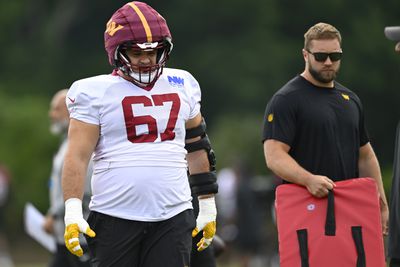
Photo by John McDonnell/ for The Washington Post via Getty Images
Nick Allegretti – presumed starter
6-4, 320 lbs, RAS 7.60, Age 28
Allegretti was drafted in the seventh round by the Chiefs in 2019. In five seasons, he has primarily been a backup. In 2020, he started 9 regular season games and three playoff games, including the Super Bowl, in relief of an injured starter. Aside from 2020, he has never started more than three regular season games with the Chiefs. Last season he once again got to start the AFC Championship and Super Bowl when primary starter Joe Thuney was injured, and exhibited real toughness to play with a torn UCL.
Signing with the Commanders gave Allegretti an opportunity to get out from under Thuney’s shadow. Over The Cap was unimpressed with Allegretti’s 3-year, $16 million contract with $9 million guaranteed, given his modest resume to date and gave the signing an F. Did Adam Peters find a diamond in the rough? Let’s see if Allegretti’s blocking stats from his prior role offer any clues.

You can see where Over the Cap was coming from. Allegretti got enough playing time to generate reliable blocking stats in three NFL seasons. In 2023, he played 160 pass blocking snaps, in 6 regular season games and three playoffs, predominantly at LG. His Pressure Rate (Press%) allowed in pass protection was better than Washington starter Saahdiq Charles (8.13%), but not enough to elevate him above the low end of NFL starters. Charles was the lowest rated starting guard in pass protection.
Sufficient SIS data was not available to grade Allegretti’s blocking in 2023, since playoff data is not publicly available.
Allegretti did a little better in pass protection in 2022, when he got more regular season playing time. There was good agreement between his pass blocking grades derived from PFF Pressure Rate and SIS Blown Block data. He graded very well in run blocking that season, as judged by blown block rates.
Allegretti’s best season overall was in 2020, when he got the most playing time and played like an average starting LG.
Chris Paul
6-4, 324 lbs, RAS 9.45, Age 25
Paul was a seventh round pick by the Commanders in 2022. Coming out of Tulsa, he got good marks for his burst and straight line speed, but graded poorly in lateral agility and blocking technique. He has two years remaining on his rookie contract.

Paul started 7 games for the Commanders last season, and was a little worse in pass protection than Saahdiq Charles. He was a little better in run blocking, but not good for a starting guard. He played 66 snaps in one start as a rookie, which is not enough to grade his blocking performance.
Michael Deiter
6-6, 310 lbs, RAS 6.74, Age 27
Deiter played in college for Wisconsin and was selected by the Dolphins in the third round of the 2019 draft. He has logged significant playing time in three of his five NFL seasons. He played LG in his rookie season and switched to center in his third season. He signed a 1-year, $1.8 million contract with the Commanders in 2024.

Deiter started 10 games at center for the Houston Texans in 2023, the most starts he has recorded since his rookie season. He graded worse in pass protection by Blown Block Rate than Pressure Rate, but both metrics rated him as below average for a starting center.
Deiter’s best season was in 2021, when he graded above average in pass and run blocking by all metrics. Overall, he grades well in run blocking, but not well consistently in pass blocking.
J.C. Hassenauer
6-2, 295 lbs, RAS 4.87, Age 28
Hassenauer was signed by the Falcons as a UDFA out of Alabama in 2018. He made his regular season debut with the Steelers in 2020, where he played as a backup center for three seasons, seeing significant playing time in 2020 and 2021. He signed with the Giants in 2023, but missed the season with a triceps injury. He signed a 1-year, $1 million contract with the Commanders in 2024.

Hassenauer has the best overall blocking grades of the experienced veterans. He didn’t get quite enough run blocking reps in at Pittsburgh to meet the 100 snap threshold (2020: 85 snaps, 2021: 95 snaps) but he came close enough that I included his grades anyway. The concern with Hassenauer is that he last got gradable levels of playing time in 2021 and is returning from injury. Also, he is pretty small for an NFL guard.
Players with Negligible NFL Experience
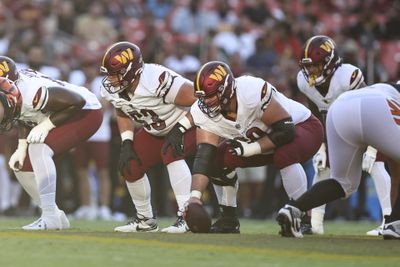
Photo by Michael Owens/Getty Images
Ricky Stromberg
6-4, 313 lbs, RAS 9.60, Age 23
Julian Good-Jones
6-5, 313 lbs, Age 27
The other two players competing for spaces on the iOL depth chart are Ricky Stromberg and Julian Good-Jones. Stromberg is a former Arkansas Razorback who was drafted near the end of the third round in 2023, and missed his rookie season with an injury suffered in the opening game. Good-Jones was signed by the Eagles as a UDFA out of Iowa State in 2020. His first appearance in an NFL game was the final game of 2023, when he played 2 offensive snaps for the Commanders. Together, Stromberg and Good-Jones have logged a total of 28 regular season snaps.
In the absence of actual NFL game experience, the best available indicators of blocking performance for these players are their stats from the first two preseason games. Since Hassenauer has not significant playing time since 2021, I included his preseason data as well. SIS does not make their preseason data available for free, so this is limited to Pressure Rate data from PFF. None of the players have got enough playing time for the data to be reliable, so I didn’t think it was worthwhile to go the extra step and provide blocking grades.

The Commanders played Good-Jones predominantly at center in the first preseason game, with some time at LG. In the second game he played 32 snaps at LG and 10 at RG.
Stromberg played 22 snaps at LG and 18 at C in the first game and then 45 snaps at RG in the second.
Hassenauer played 21 snaps at RG in the first game and 27 at C in the second.
To this point in the preseason, one of these guys looks different from the other two. Ricky Stromberg has flown under the radar since returning from injury this offseason. He is quietly having a good preseason. In two games so far he has only allowed one pressure in 59 snaps. That’s not enough of a sample to reach any firm conclusions, particularly since he is playing against backups and roster bubble players. But it is a promising start.
In the same games, against the same competition, Julian Good-Jones has done nothing to inspire confidence. Hassenauer has also not stood out in limited preseason snaps.
How Much Improved is Left Guard?
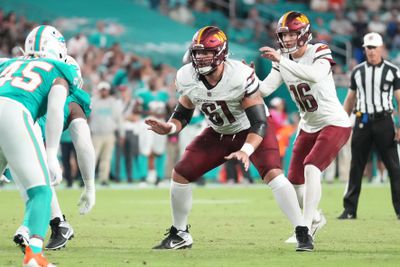
Photo by Peter Joneleit/Icon Sportswire via Getty Images
Last season the Commanders had the worst left guards in the NFL, and the position was the weakest link on the OL.
The highest profile addition to the iOL, aside from new starting center Tyler Biadasz, was former Chiefs backup LG Nick Allegretti. When he did get playing time in Kansas City, Allegretti performed well in run blocking, but played at replacement level in pass blocking. Allegretti seems to have a clear edge over returning LG Chris Paul who played abysmally in 2023. However, if he plays like he did with the Chiefs, he could find himself facing competition for his starting position. At least he might, if there was anyone to compete for it.
The other two experienced veteran additions have primarily played at center, with some time at LG. In seasons when he got playing time, Deiter grades fairly similarly to Allegretti, doing better at run blocking than in pass protection. Hassenauer graded better than Deiter early in his career, but hasn’t seen significant playing time since 2021.
Perhaps the brightest glimmer of hope for significantly improved play at LG is second year player Ricky Stromberg. But at this point in time, that is pure speculation. Returning from the knee injury that sidelined him as a rookie, Stromberg was relatively quiet in training camp. He has looked good in two preseason games. But that is too small a sample to reach any firm conclusions.
Julian Good-Jones has done nothing to move the needle in preseason or two regular season snaps in 2023, which is the extent of his NFL resume.
Overall, the Commanders have shored up the weakest link on their O-Line by adding players who seem to offer the potential for significant improvement in run blocking. However there is little reason to hope for substantial improvements in pass protection, which is the greatest area of concern with a rookie QB. Aside from an unexpected surprise, the best hope in that regard would seem to rest with the development of younger players Ricky Stromberg or Chris Paul. If not, it will be a job for next offseason.
